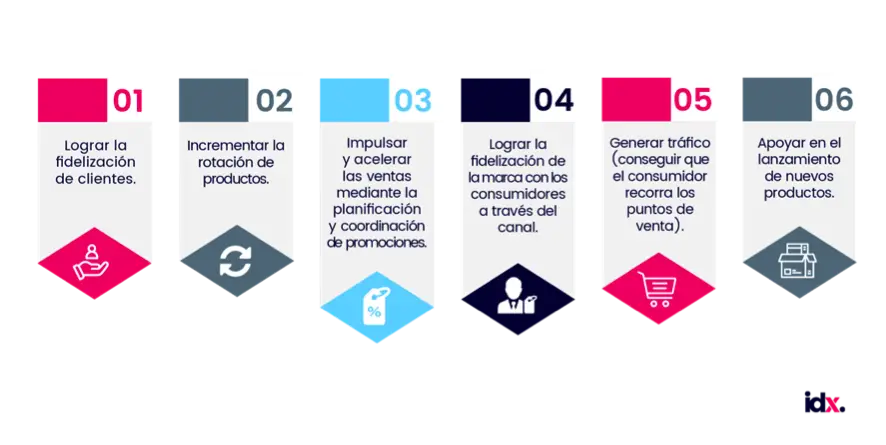There are endless definitions and explanations about what is Trade Marketing. We understand it as the set of actions and strategies that are carried out to make the point of sale a much more attractive place, aimed at improving the customer's shopping experience. In other words, it is a way to achieve through the physical store, a greater presence of the brands in the market and in the minds of the public. In this way, a greater number of sales are generated.
Who are in charge of carrying out Trade Marketing?
Trade Marketing could not exist without the joint work of manufacturers and distributors. They are the main players in the distribution channel and are responsible for providing a better commercial outlet for products.
Thus, they are responsible for making products more attractive within the distribution channel in which they operate.
When did it appear?
This type of marketing emerged around 25 years ago. Following a series of changes in the business landscape, there was a fragmentation of the traditional media and channels, at the same time as the retail business was consolidated. In this way, its work becomes more prominent and promotions aimed at it begin to be developed.
A new area of work is consolidated that seeks to support the work of the retailer, through marketing actions at the point of sale itself.
What objectives does Trade Marketing seek to achieve?
With a clear focus on improving sales in the establishments themselves, Trade Marketing strategies and actions seek to achieve the following objectives:
- To build consumer and customer loyalty through the distribution channel
- To improve product rotation at the point of sale
- To boost and accelerate sales through the planning and coordination of promotions.
- To develop merchandising and branding actions.
- To generate greater traffic at points of sale.
In short,the ultimate objective of Trade Marketing is that the product is represented on the shelf, in a privileged position and with sufficient inventory at the physical point of sale. All this in order for the consumer to find the product he requires, without any difficulty.

Some key actions...
- Offering affordable pricesthrough consumer and distributor channels. In this type of action, the aim is not to lower the cost of products. The aim is to provide offers that both channels will need during the production and distribution process.
- Improve communication between all the channels involved. The aim is to solve quickly and efficiently any problems that may arise between manufacturer and distributor, or between distributor and buyer. Any loss of quality or brand image is avoided.
- Contacting other brands to sponsor the whole process of buying and selling new products. On many occasions, the consumer is faced with products that do not have a brand or identifying sign. This is not a favorable situation for companies. For this reason, it is necessary to reinforce brand identity right from the product production phase.
- Pay attention to the small details. Taking care of the appearance and presentation of the products means a series of advantages for the company. These advantages lead you to generate added value around your brand and the point of sale. This is a fundamental action that can lead to greater demand in the short and long term.
- Improve logistics. This action must be aimed at delivering the product at the exact date, time and place. An end that takes on greater importance - and is already taken for granted - when dealing with products of an online nature.
- To carry out actions aimed at improving product rotation at points of sale. Coordination of certain types of promotions or offers, the implementation of actions related to merchandising or some actions that are capable of generating traffic to the points of sale.

Sectors in which Trade Marketing operates
Understanding and knowing how to manage the point of sale, as well as directing part of the business efforts to certain key sectors is a task of great importance. Among these key sectors are:
- Distributors. Their role is critical in helping the product to be widely distributed and reach the end consumer. It acts as a means to ensure inventory delivery. In addition, it ensures consumer availability the territory from which it is being sold.
- Physical points of sale. Despite the importance that e-commerce is acquiring, it continues to impose itself as the strategic center of all commercial activity. A good shopping experience is essential for customer loyalty and attracting new customers.
Practical examples
Have you never gone to the supermarket and, while turning down one of the aisles, come across a taste test? This is a clear example of Trade Marketing.
Brands agree with supermarkets to promote a particular product, in a mutually beneficial arrangement. The ultimate goal is for the user to buy. This type of practice is usually developed with everyday products or food that can be found in any supermarket or shopping center.

The training and presentation of your product or service to those in charge of its sale and distribution is another example. It brings value to the human capital of the company and involves much more workers, key pieces of the point of sale. This practice is developed when it is a very new product.
Nowadays, brands face two major problems that make it difficult to launch their products. On the one hand, they have to face the high competitiveness of distribution channels and, on the other, they are faced with a consumer who is less loyal every day, is more informed and has a large off and online offer.
This is why Trade Marketing plays a fundamental role. It helps brands to achieve better results, be more present in the minds of their audiences and differentiate themselves from their competitors.
As a result of this process, we are witnessing a wave of new formats, technologies and products aimed at creating new experiences that add value to the business and leave an impression on the consumer. The point of sale is evolving and becoming stronger thanks to digital transformation.
Campofrío business case
At DeuSens we develop technological solutions aimed at solving this situation. With the incorporation of Augmented Reality, Virtual Reality or Mixed Reality, great results can be achieved:
- Generate great impacts within the point of sale.
- Facilitate the work of manufacturers and distributors.
- Get a positioning in the mind of the consumer and above competitors.
A very close example of this was the Augmented Reality project we developed for Campofrío. It consisted of introducing the "wow-effect" at the point-of-sale.
SIMILAR CONTENT












 RETURN
RETURN







